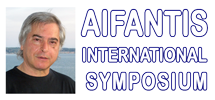List of Accepted Abstracts As of 15 March 2015: (Alphabetical Order)
Aifantis International Symposium
(2nd Intl. symp. on Multiscale Material Mechanics in the 21st Century)
Gudenau International Symposium
(3rd Intl. Symp. on Advanced Sustainable Iron and Steel Making)
Takano International Symposium
(1st Intl. Symp. on Sustainable Metals & Alloys Processing)
Meech International Symposium
(2nd Intl. Symp. on Sustainable Mining Operations)
2nd Intl. Symp. on Sustainable Mineral Processing: Principles, Technologies and Industrial Practice
Vanyukov International Symposium
(3rd Intl. Symp. on Sustainable Non-ferrous Smelting and Processing)
3rd Intl. Symp. on Sustainable Materials Recycling Processes and Products
3rd Intl. Symp. on Quasi-crystals, Metallic Alloys, Composites, Ceramics and Nano Materials
2nd Intl. Symp. on Sustainable Cement Production
4th Intl. Symp. on Environmental, Health, Policy, Legal, Management and Social Issues Related to Metals, Materials and Mineral Processing
2nd Intl. Symp. on Rare Earth and Platinum Group Metals: Managing and Processing
2nd Intl. Symp. on Sustainable Production of Ferro-alloys
3rd Intl. Symp. on Sustainable Molten Salt and Ionic Liquid Processing
2nd Intl. Symp. on Sustainable Secondary Battery Manufacturing and Recycling
2nd Intl. Symp. on Sustainable Base-metal Bio-extraction
2nd Intl. Symp. on Synthesis and Properties of Nanomaterials for Future Energy Demands
2nd Intl. Symp. on Sustainable Energy Production: Gas/Oil/Shale; Coal; Nuclear; Waste/Bioprocessing and renewables: wind/waves
3rd Intl. Symp. on Composite, Ceramic and Nano Materials Processing, Characterization and Applications
2nd Intl. Symp. on Sustainable Surface and Interface Engineering: Coatings for Extreme Environments
1st Intl. Symp. on Physics of Surfaces and Interfaces, from Fundamentals to
Sustainable Applications
1st Intl. Symp. on Advanced Materials and Technologies for
Sustainable Energy and the Environment(AMTSEE)
1st Intl. Symp. on Multifunctional and Smart Materials, Systems and Structures for Sustainability (MSMSSS)
2ND INTL. SYMP. ON SUSTAINABLE PRODUCTION OF FERRO-ALLOYS
Advanced Oxygen Lances for Furnace Tapping Operations
P.
Sylven1 ;
1ENVICOM AB, uddevalla, Sweden;
Type of Paper: RegularDespite being crucial for the smelting process, furnace tapping using oxygen lances has not been considered an operation that brings added value. Therefore, these important tools have not seen a significant change in over 100 years. Until now. Well-known problems related to the use of standard oxygen lances include, but are not limited to:
-Inaccurate tool: causing damages shortening the life of the tap hole refractories, which adds cost and loss of production.
-Safety: extended exposure to the operator in an unsafe area of the furnace.
-Cost: high oxygen consumption & high lance consumption.
-Time consuming and frustrating to connect one lance to another; increased waste and cost.
A lot of these drawbacks are related to the Bounce Combustion effect. This is the key factor affecting oxygen lance consumption and accuracy. These consequences appear when the lance, due to lack of power inside a passage, has to be pressed against its attack point. That pressure generates an undesired radial combustion, speeds up its consumption and generates an irregular perforation. Thus, the Bounce Combustion effect lowers the lance's capability to concentrate all its energy at the attack point, wasting energy on its own consumption and tearing up undesired zones of the passages. This paper will describe the bounce effect in more detail. It will also suggest a very good solution; The Trefimet thermal lances. This paper will show how these provide an outstanding performance for a more efficient, faster and cost-effective furnace tapping operation. These new lances are very accurate tools that enable the operator to perform a more controlled operation; resulting in longer tap hole life, fewer repairs and less down-time. Keywords: tap hole, tapping, oxygen lance, clay, refractory
Improving Wear Properties of High Chromium Cast Iron by Manganese Alloying
H.
Ali1 ;B.
Khedidja1 ;
1BADJI MOKHTAR UNIVERSITY ANNABA ALGERIA, Annaba, Algeria;
Type of Paper: RegularHigh chromium cast irons are widely needed by several industrial areas where the environment is dominated by wear. They are used in mining, cement, steel-making plants and many others. Their microstructure consists of netted eutectic carbides embedded in an austenitic or martensitic matrix. The wear behaviour is mainly controlled by the carbides shape and also matrix type. Several scientific works try to improve the wear behaviour and to optimize the life service of this cast iron by using varied techniques. In this work we intend to study the effect of manganese content on the microstructure properties and wear behaviour of a 15% chromium white cast iron used for mill ball production. The present work treats the wear behaviour, after heat treatment, of a manganese alloyed high chromium cast iron. A set of specimens were melted in an induction oven by varying the manganese content in the range 0-3%.
Heat treated samples are analysed by optical microscopy, MEB, DSC and DRX and wear tested by abrasion and friction. Increasing the manganese addition gave a structural evolution and a wear resistance improvement. The best wear behaviour is obtained with samples containing 3% Mn. Keywords: Chromium cast iron, carbide forming elements, eutectic carbides, secondary precipitation, abrasion, and friction.
Optimization of Refractory Linings in Ferroalloy Production
C.
Wenzl1 ;A.
Spanring1 ;
1RHI AG, Vienna, Austria;
Type of Paper: RegularHigh intensity processes and new furnace designs, as well as adaptations of existing processes (e.g., due to changes in ore quality), present a challenge for metallurgists and equipment suppliers, including refractory producers. The refractory lining is a main factor for safe and economic furnace operation as it provides the main barrier between hot molten phases and the environment - a failure not only can lead to equipment damages, but it also presents a risk for the operating personnel. RHI has been providing high quality refractories and complete lining solutions for ferroalloy vessels for many years. Continuous improvement and development, as well as expert knowledge of metallurgy and equipment, are key factors for dealing with new process and design challenges. The present paper provides an overview of optimization potentials in ferroalloy linings and RHI's approach to providing functional and comprehensive refractory solutions. Keywords: Ferro-Alloys; Furnace; Production; Smelting;
Phase Diagrams with Allotropies and System Fe-Co-S
V.
Lutsyk1 ;V.
Vorob'eva1 ;E.
Nasrulin1 ;O.
Sumkina1 ;
1INSTITUTE OF PHYSICAL MATERIALS SCIENCE SB RAS, Ulan-Ude, Russian Federation;
Type of Paper: RegularThe study of the sulfide system Fe-S-Co was limited by the quasi-binary section through the compositions of congruently melting sulfides FeS and CoS. The fields of all three polymorphous modifications of iron are located on the T-x-y diagram liquidus of the subsystem Fe-FeS-CoS-Co: high-temperature delta-Fe, intermediate gamma-Fe and low-temperature alpha-Fe. Besides them, on the diagram there are fields of the liquidus of the incongruently melting compound Co4S3 and the solid solution formed by the compounds FeS and CoS. A transition from the high-temperature polymorphous modification of iron to the intermediate one occurs according to the univariant metatectic reaction L+delta-Fe=gamma-Fe(Co), and from the intermediate modification to the low-temperature one according to the invariant reactions in the presence of the solid solution FeS(CoS) or the compound Co4S3: L+gamma-Fe(Co)=alpha-Fe(Co)+FeS(CoS) and L+gamma-Fe(Co)=alpha-Fe(Co)+Co4S3. Furthermore, the ternary eutectic invariant reaction takes place: L=alpha-Fe(Co)+FeS(CoS)+Co4S3. As a result, the T-x-y diagram consists of 69 surfaces and 28 phase regions. The T-x-y diagram 3-dimensional (3D) computer model is designed into several stages. First, the prototype is formed. It consists of the ruled surfaces, which are the boundaries of the 3-phase regions: 8 with the liquid L and 3 without it. Three horizontal (isothermal) planes are formed automatically above and lower. These are the complexes, each of which consists of 4 simplexes and corresponds to one of 3 invariant reactions. Then, 5 surfaces of liquidus, 5 solidus, 10 solvus, two pairs of the surfaces of transus, between which are located two regions of the coexistence of iron in two versions of the allotropy: delta- Fe and gamma-Fe, gamma-Fe and alpha-Fe, are constructed. 3D computer model of the real system is obtained after correction according to the experimental data of the curvature of lines and surfaces. It makes it possible to construct any isothermal section and isopleth and to demonstrate the results of the mass balances calculations, so that it is possible to see, as the phase and conglomerate concentration of the heterogeneous mixture changes with a temperature decrease.
The work was partially supported by the Russian Foundation for Basic Research (projects 14-08-00453 and 14-08-31468). Keywords: Ferro-Alloys; Metallurgy; Metals; Technology;
« Back To Technical Program
|



